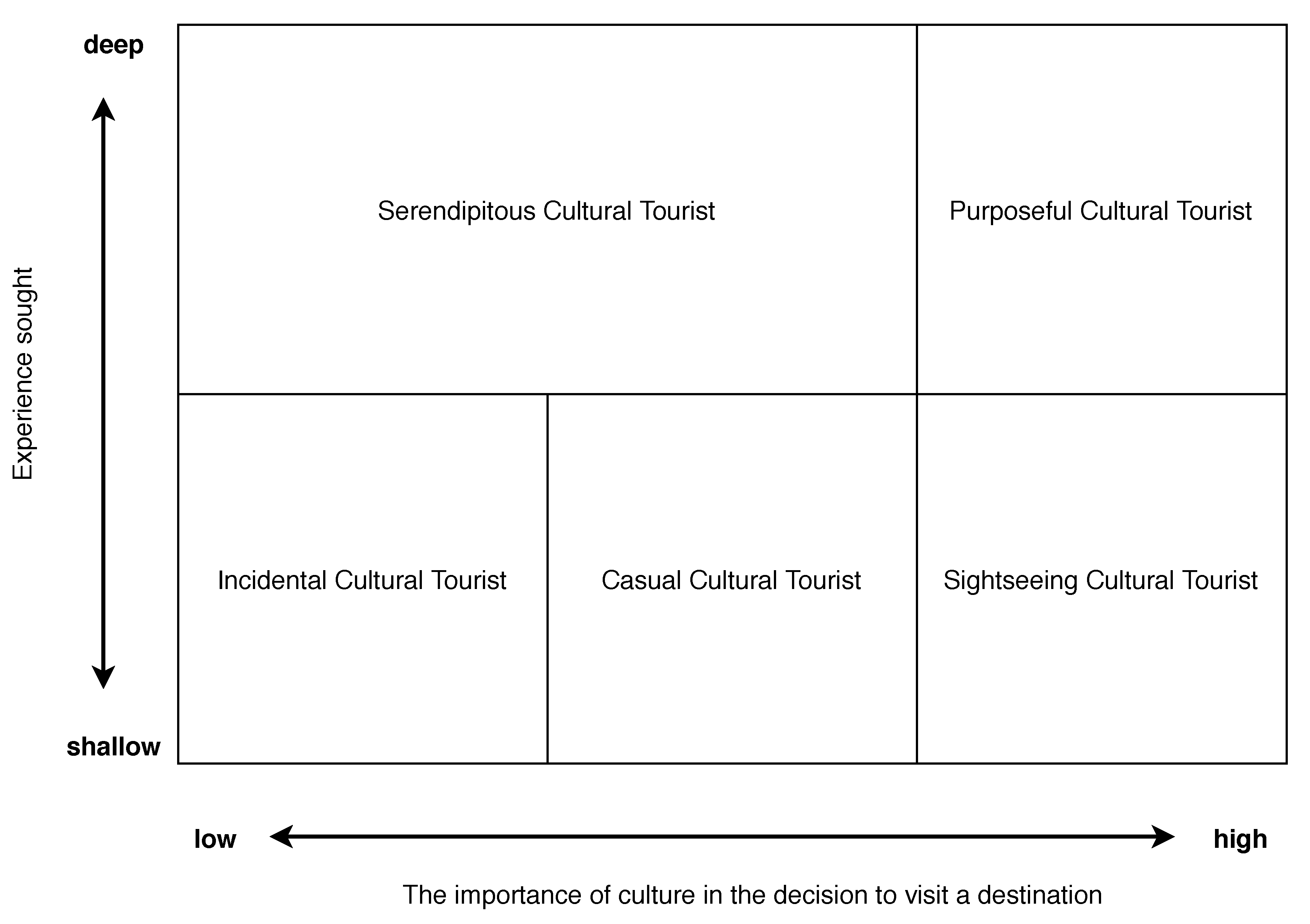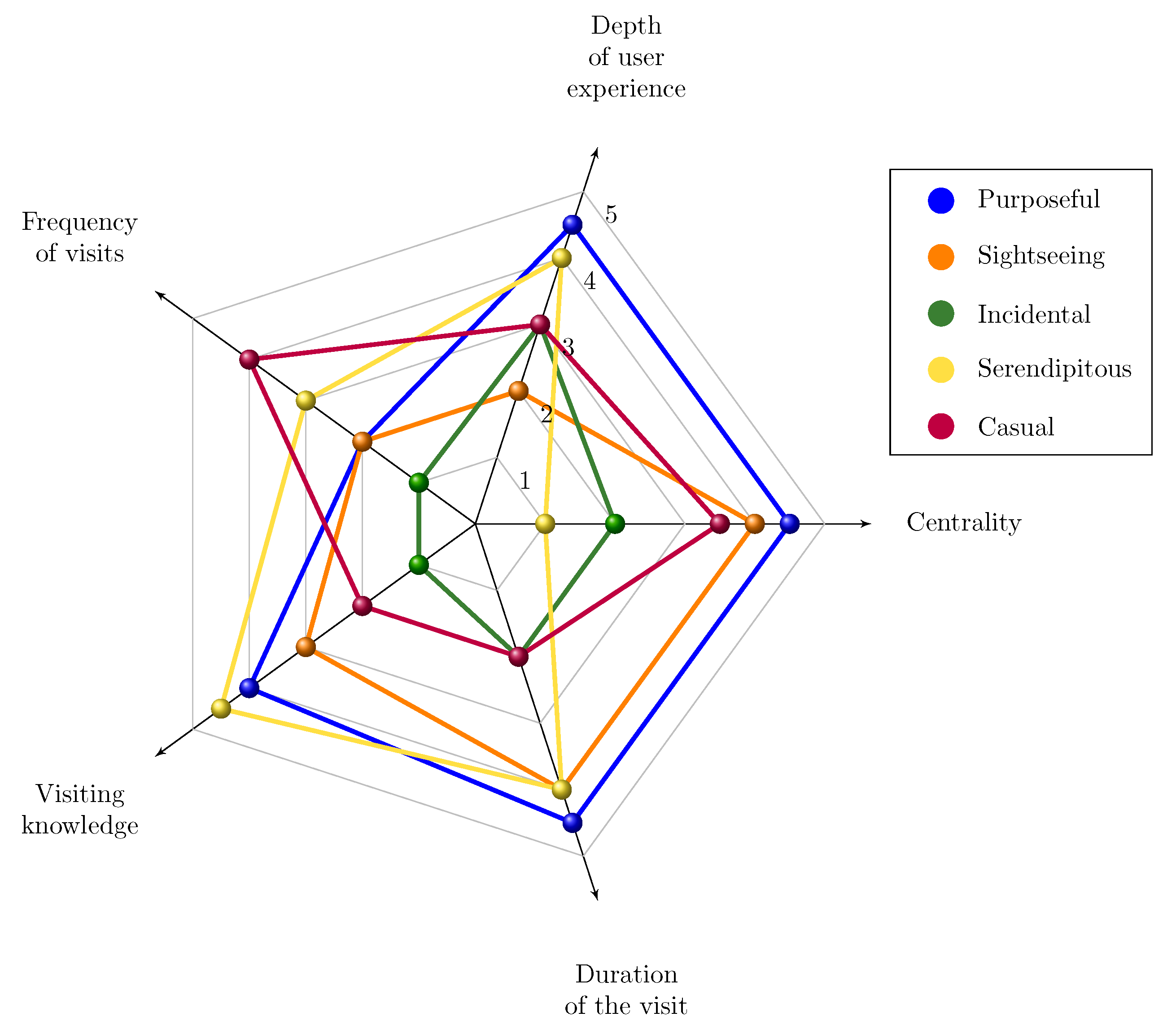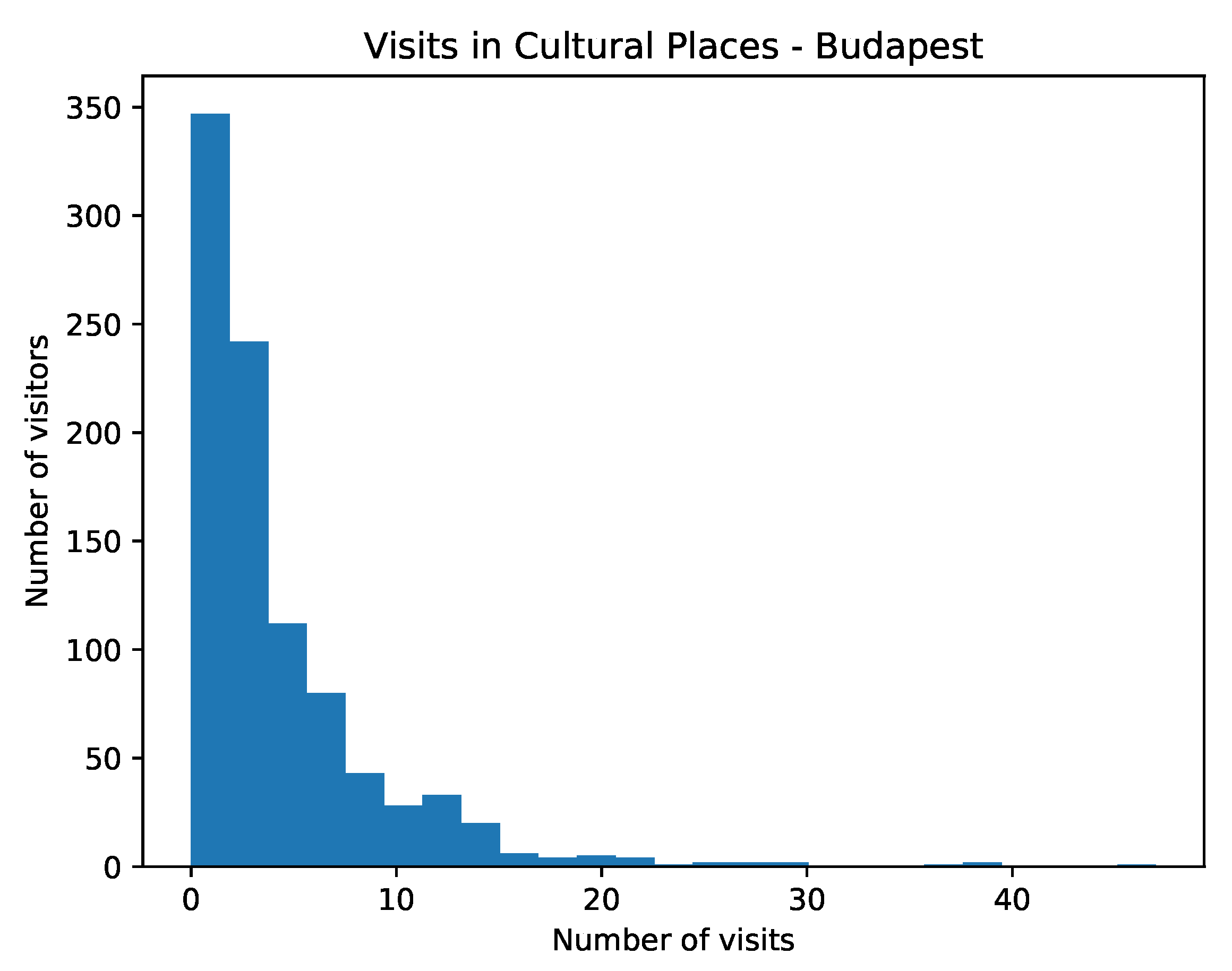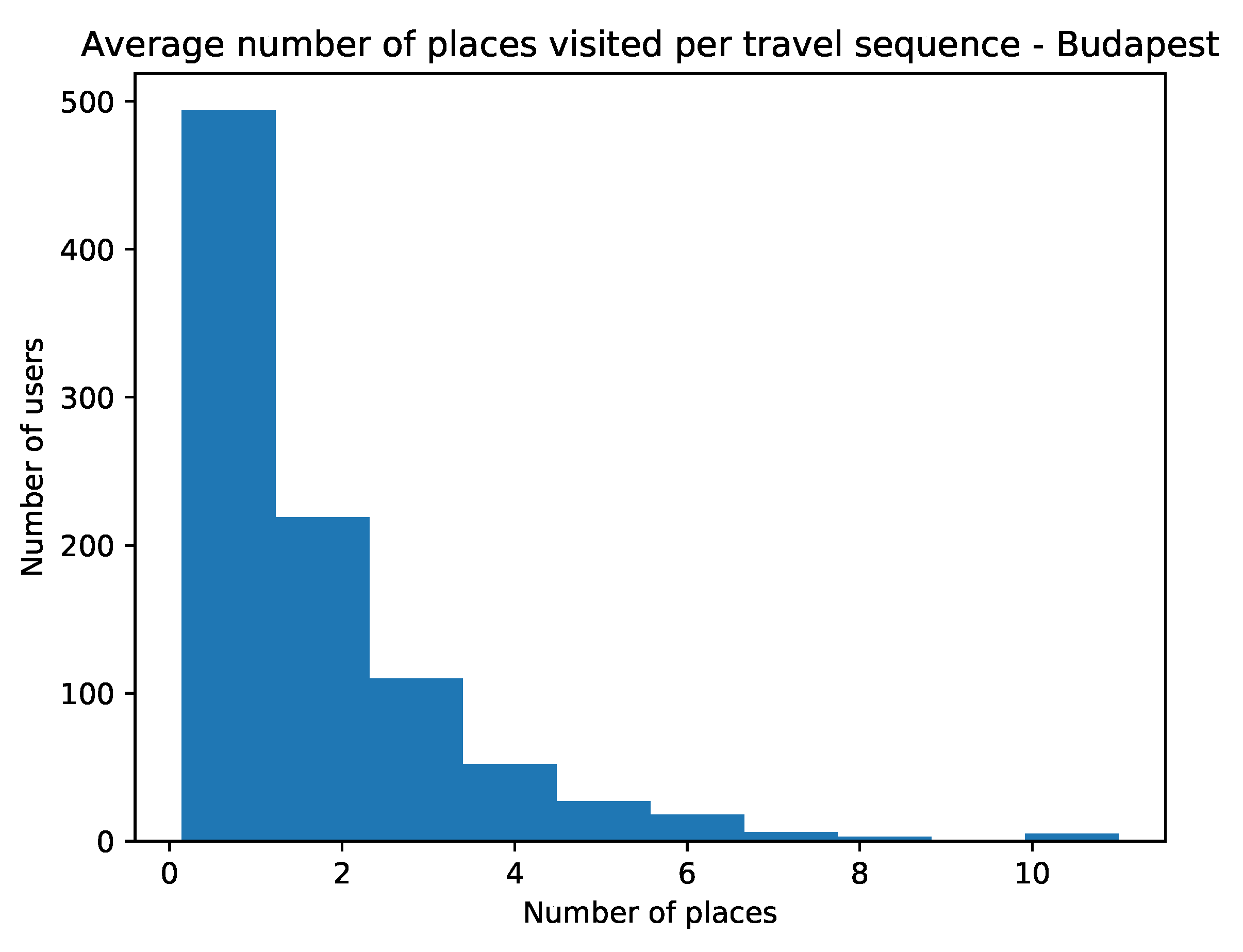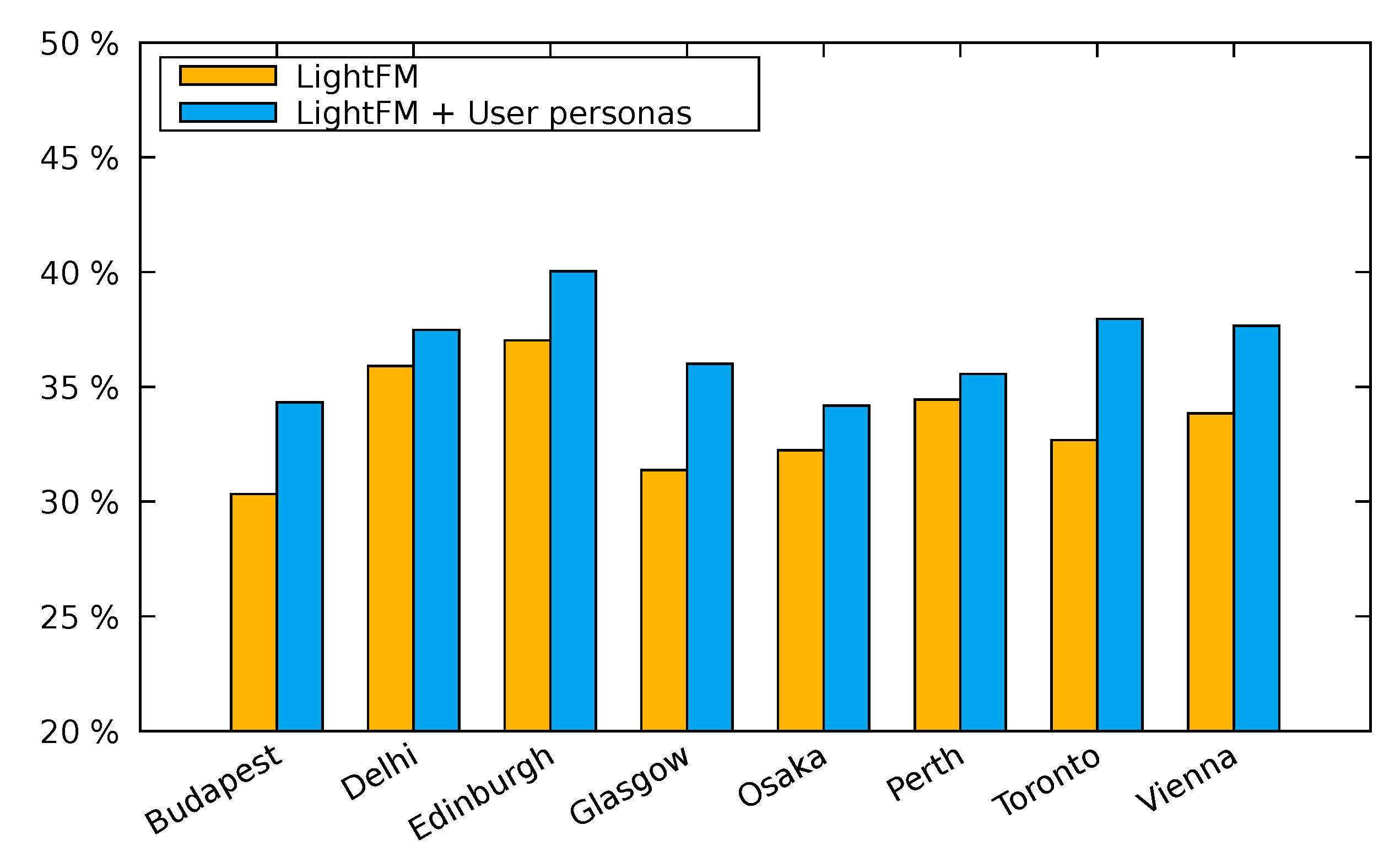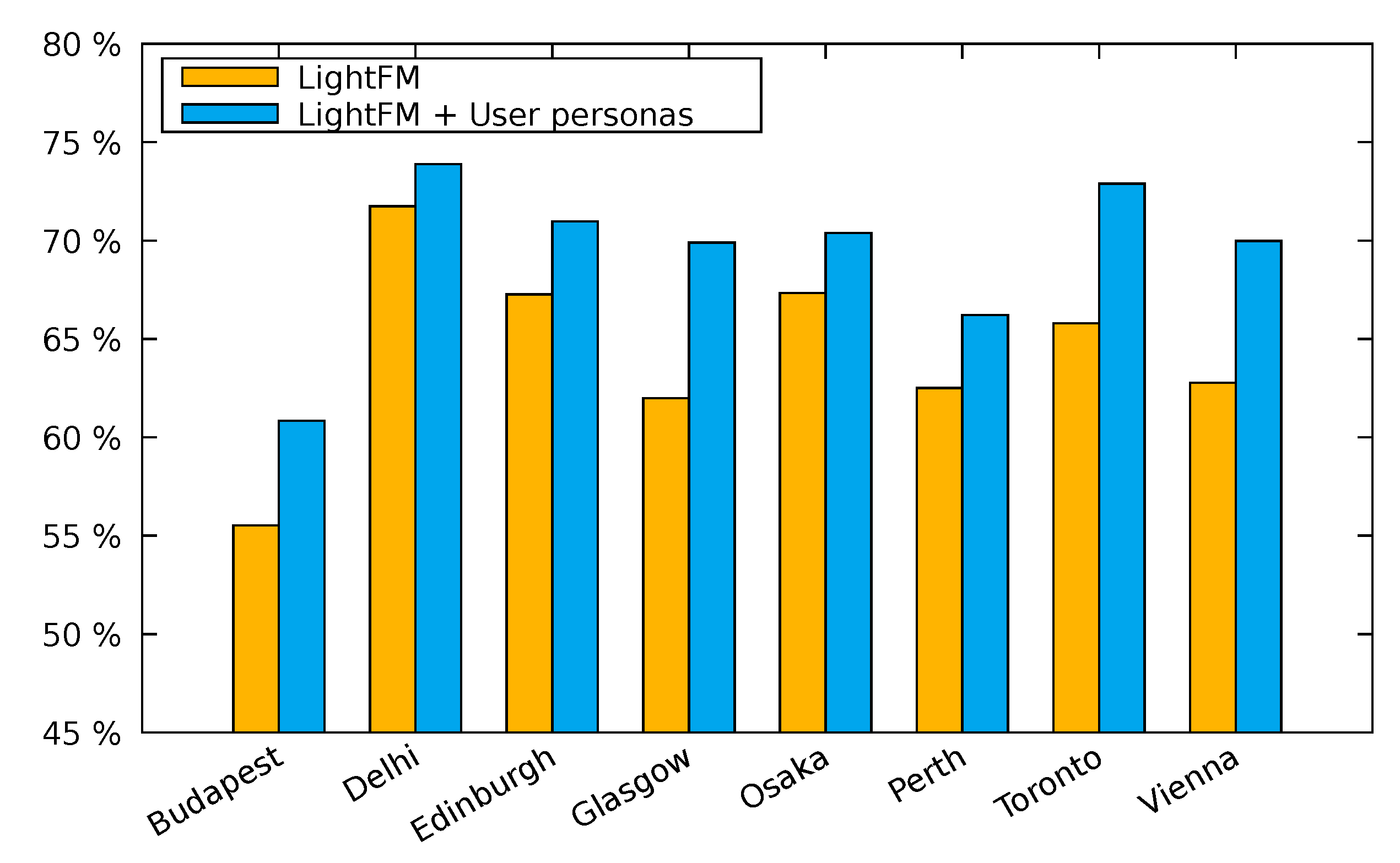1. Introduction
In recent years, user adaptive systems have become popular in many application areas, including the cultural tourism domain, which is nowadays recognized as one of the most important forms of touristic traffic. The proliferation of user-adaptive
recommender systems (RS) in this area is growing rapidly, since cultural tourism is an activity strongly related to the personal desires and interests of visitors [
1]. The large number of resources and data available online have resulted in the fast dissemination of cultural information, but, on the other hand, they have also contributed to the problem of
information overload; that is, the difficulty in identifying those resources best suited to each individual’s needs.
Therefore, managing these voluminous resources with principles and techniques pertaining to big data analytics, in an effort to offer suitable and personalized support to visitors, constitutes one the most interesting challenges in this research field. In this sense, it is of vital importance to be able to segment cultural tourists, taking into account their whole cultural experiences. However, although cultural tourism shows remarkable growth and popularity, little research has been done to categorize cultural tourists by integrating both their cultural centrality (e.g., cultural motivation, importance of culture in the decision to visit) and depth/levels of cultural experience [
2,
3,
4].
In light of the above, further interest in studying cultural tourism and its participants has been developed, as they exhibit their own distinct characteristics. It is an indisputable fact that experiencing cultural assets plays an important role in motivating a person’s travel decisions. Nevertheless, cultural tourism destinations require a more precise categorization of their visitors and their underlying motivations, since not every person is motivated by the same reasons for learning, experimenting or self-exploring. Because of this assumption, that cultural tourists are not alike, most of the literature in cultural tourism follows a segmentation approach, giving emphasis in determining the typology of the cultural tourists [
5]. Consequently, McKercher [
6] developed a relevant typology by addressing two fundamental dimensions;
cultural centrality and
depth of user experience. The aforementioned typology provides a useful and functional framework for segmenting cultural tourists and has been further tested and employed in subsequent empirical studies [
7,
8].
Recommender systems are a key technology in addressing the concerns outlined above and assist travelers in making optimal decisions. In principle, a well-designed and effective RS can help a cultural visitor in exploring, comparing and choosing the most interesting destinations that fit his/hers preferences and needs. Most modern RS operate by modelling both potential visitors and destinations; that is, by studying past interactions of their users and the places they have visited, along with explicit preferences, usually expressed on a rating scale. In order to provide users with personalized recommendations, RS eventually select the most relevant destinations that match with the modelled user’s profile. Therefore, user profiles are an important RS component, playing a key role in its effectiveness [
9]. In this sense, any additional information relevant to each user’s taste is expected to further improve the quality of the recommendations.
In this regard, the main goal of this work is the enhancement of the user profiles built by cultural RS through the incorporation into them of additional information regarding the cultural tourist type, as assessed by the McKercher’s framework. More specifically, this work extends collaborative filtering matrix factorization algorithms, considered to be the state-of-the-art in RS, through the inclusion of the each user’s cultural profile in the factorization process, as obtained by the aforementioned framework. To the best of our knowledge, our work is among the first to address cultural recommendations in this dimension, while the outcome of this study provides a better understanding in the areas of segmenting, profiling and recommending for cultural tourists. The rest of this paper is organized as follows;
Section 2 presents a literature overview of cultural tourism, visitor profiles and recommender systems.
Section 3 outlines the proposed methodology, while
Section 4 presents the data used in the experiments.
Section 5 discusses obtained results and finally, the work concludes in
Section 6, where some general remarks are made and possible future directions are also considered.
2. Literature Review
Cultural tourism is a type of tourism particularly relevant to a destination’s culture and more precisely with aspects such as the lifestyle, history, arts, architecture, religion, heritage and other related elements. Travellers who participate in this form of activity, by visiting cultural places and organizations are considered to be “cultural tourists” [
10]. Of course, this definition is too broad; indeed, all tourists may be involved in cultural activities, in one way or another. For this reason, several studies examine the heterogeneous nature of cultural tourists, proposing various typologies and segmentations [
11].
Niemczyk [
12] considers cultural tourism as a type of travel from a person’s area of residence during vacation, for a period of time not more than 12 months. This involves the individual being aware, to some extent of the place of visit, in which culture (the core element of the tourist experience) plays a significant role when planning the journey. A number of studies [
13,
14,
15] indicate that cultural tourists tend to be better educated and older than the general travelling public. Additionally, they stay longer in a particular area, participate in travel activities more often than other categories of tourists and spend more money in the places they visit [
13]. Women constitute an important part of this type of tourism [
15], while cultural travellers are more likely to use a variety of sources to gather information when planning trips [
14].
Specialized literature attempted to classify tourists on the basis of their chosen activities, motivations, lifestyles and depth of experience. Stylianou-Lambert [
10] tried to explain the differences between cultural tourists in art museums, interviewing participants from Cyprus. De Simone [
16] studied the relationship between tourist typologies and heritage tourist attitudes, based on demographics, travel behavior, experience and satisfaction. Nguyen [
8] categorized heritage tourists in Vietnam, using a questionnaire survey with two basic variables; the importance of cultural tourism in the decision to visit a city and the depth of cultural experience. Also, Konstantakis [
17,
18] proposed two different methodologies; CURE and REPEAT. The former identifies and extracts cultural user personas by eliminating the requirement of explicit user input, while the latter processes implicit data from users’ mobile devices and explicit data from users’ answers into a questionnaire, in order categorize each visitor and assume the personalization level that fits his/her interests better.
Meanwhile, McKercher [
11] developed a cultural tourist typology addressing two dimensions; the centrality of cultural tourism and the depth of cultural engagement, thus providing a useful and functional theoretical framework [
4], which has been further tested [
11] and employed in subsequent empirical studies. Taking into consideration the importance of cultural heritage in the final decision to visit a destination and the experience the user is seeking, McKercher distinguishes five types of tourists (
Figure 1):
The purposeful cultural tourist, for whom the main purpose of visit is gaining knowledge of another place’s culture. Learning the cultural heritage of a place is an important reason to visit a destination and this kind of approach creates a deep cultural experience.
The incidental cultural tourist, for whom culture does not play any role in the decision to visit a particular cultural destination and even though s/he might visit one, his/her participation in cultural events is minimal.
The serendipitous cultural tourist, for whom culture plays little or no role in the decision to visit a particular cultural destination, but if s/he finds himself/herself in one, his/her participation in cultural events is maximal, resulting in a deep cultural experience.
The casual cultural tourist, whose focus on cultural matters is of little importance when planning to travel, and even in the event of encountering cultural activities, their cognitive impact is rather shallow on him/her.
The
sightseeing cultural tourist, who desires to gain knowledge about the culture of another place, but in reality his/her visit is of a rather loose nature, focused on entertainment [
12].
Furthermore, Kantanen and Tikkanen [
19] were based on McKercher’s typology to examine the impact of cultural tourism on visitors’ perception processes concerning cultural attractions. Finally, Vong [
7] examined the cultural tourist typologies in Macau pertaining to an urban game, by employing McKercher’s typology through a questionnaire survey in visiting tourists.
To date, only a handful of studies have attempted to examine cultural tourism experience and the technological impact from a holistic point of view. The integration of
information & communication technologies (ICT) has benefited the promotion of cultural experiences. With the development of new technologies, modern types of tourist activities are growing, which are capable of transforming and augmenting cultural tourism experience in a higher level. These new augmented experiences are expected to increase user engagement, allowing technology to function either as a mediator or as the core experience itself [
20].
A key element for the introduction of ICT in the cultural heritage domain is the perceived
user experience (UX). Cultural institutions should consider that their visitors come from different backgrounds and have mixed expectations during their visits. Their engagement with the exhibits or ICT also varies. Therefore, it is of major importance to be able to understand and adapt the technology in order to offer a meaningful experience to visitors. Cultural spaces should adjust the use of traditional ways of presenting exhibits to a more relevant way, in line with technological changes, whether by using more effective digital media or interactive exhibits [
21].
In this regard, RS are one of the principal ways of delivering personalized content to the visitors of a destination. RS are software systems that try to model their users’ unique taste, based on the interactions the latter have with the places they visit [
22]. This interaction is typically multimodal; it might be
explicit, when a user actively evaluates a place s/he visits and/or
implicit; when the interaction between a visitor and a place is deduced by the system itself. In the first case, user opinion might be expressed in a number of ways; e.g., through ratings on a predefined scale (like/dislike, 5-star system, etc.), through answered questionnaires or even through free-form text (comments, etc.). In the latter case, user preference is extracted from his/her actions; e.g., visiting/“checking-in” a place or taking photos. Of course, the former type of interaction is highly desired because it is more closely related to the actual taste of the visitor. However, it requires a high level of user engagement in order to be efficient, which, obviously, cannot be guaranteed for every potential user.
Recommender Systems can be incorporated in the cultural domain in a number of ways. Their most widespread application is probably in proposing places to visits, known as
points of interests (POIs), in the form of a ranked list. POIs may range from geographical areas and cities to particular places within a city [
23] or even specific locations within a cultural heritage site, such as an archeological site or a museum [
24]. An extension of the aforementioned systems are RS that recommend
paths or
travel routes; in this case, the route is modelled as a sequence of spatially correlated POIs to be visited in a pre-defined order. Again, the route may involve a broad geographical area of POIs that are many kilometers apart, locations within a city [
25] or even exhibits within a constrained heritage space (museum, cultural site) [
26]. Apart from proposing spatially correlated POIs that are of interest to their users, path RS are also usually bounded by the route itself; in total duration and/or distance. Finally, cultural RS may also be used to suggest experiences, such as activities and events.
In this work, a cultural RS that produces a list of suggested POIs to visit is going to be outlined. The proposed system is going to model implicit user interactions, as this type of data are more robust and can be obtained in an unobtrusive manner, that does not affect the overall UX. In order to produce more efficient recommendations, users are going to be profiled according to their cultural persona type, based on additional variables (apart from centrality and depth of experience), such as frequency of visits, visiting knowledge and duration of the visit. The proposed cultural typology differs from the previous works and provides an enriched information system which, in turn, is going to be fused in the recommendation process, as it shall be described in more detail in the subsequent section.
5. Results
Figure 5 and
Figure 6 summarize the results of the experimental procedure for all cities in the examined dataset. Two distinct RS have been considered; the first one is the
LightFM [
31] CF MF approach outlined in
Section 3.3, which factorizes the interaction matrix of user visits to POIs. In order to study the effect of the computed user personas, the second RS is also based on
LightFM, but the factorization scheme is hybrid in this case; the user features are augmented with the five additional personas features computed in
Section 4.2, designating the extend to which each user belongs to each of the 5 pre-defined cultural tourist type categories (the source code used in the experiments is available at
https://github.com/ii-aegean/user-personas-recommender). Otherwise, the rest of the parameters and hyper-parameters are the same for the two RS; the cardinality of the feature space is set to
, the number of epochs for the factorization process is also set to 20 and the learning rate is set to
. Additionally, L2 regularization is imposed on the user features, with the optimal value having been determined to be, after experimentation,
for the cities of Vienna, Edinburgh and Toronto and
for the rest. Finally, the test set size has been set to
of the total number of interactions and the results presented in
Figure 5 and
Figure 6 are the averages of 10 different runs, whose statistical significance is assessed by the
Wilcoxon singed rank test (
).
System performance has been evaluated on a set of two metrics that are commonly used in offline RS evaluation [
36]. Both metrics are calculated over a list of personalized recommendations returned by the system for each particular user. The first one is
precision, which is the fraction of those items in the recommendation list that are actually of interest to the user, over all items in the list. Naturally, an ideal RS will only produce meaningful recommendations and would achieve a
precision. In practice and when comparing different RS algorithms, a higher precision score is an indication that the examined system adapts better to the taste of the users.
Figure 5 displays the
Mean Average Precision (MAP) metric computed over a list of three recommended items. MAP designates the mean of average precision, where average precision for a list of length
l and for a user
u is defined as
is the precision at cut-off point
i in the list,
is the set of relevant items for
u and
is equal to 1 if the
i-th list item is relevant for
u and zero otherwise. The presented results indicate that the hybrid factorization scheme that takes into account the user personas produces better recommendations than the vanilla algorithm. More specifically, a performance improvement of about
is achieved on this metric, which the largest difference being recording in Toronto (more than
) and the smallest in Perth (little less than
). These differences are attributed to the peculiarities of the dataset (
Table 5), since the userbase and the interactions in the city of Perth are among the smallest in the dataset and therefore the extracted personas information is not as rich as in the case of Toronto, which is the biggest subset of the data.
The second metric to be examined is the
Mean Reciprocal Rank (MRR), which quantifies how “high” in the recommendation list lie items relevant to the user. Even when a RS is able to produce meaningful recommendations, those should appear higher in the list (e.g., fist, second, etc.). Otherwise, if the first items in the list are not relevant to the user, s/he may be frustrated by the overall experience and interaction with the system. Therefore, when a RS algorithm achieves a higher MRR score compared to another one, it actually means that it is able to place relevant recommendations (to the user) higher up in the produced list. More formally, MRR is defined as
where
designates the position of the first relevant item for the
l-th user in the recommendation list. The inclusion of the user personas in the factorization scheme results in relevant items being placed “higher” in the recommendation list, yielding a performance improvement in this case as well, which is
on average; the largest being around
in Toronto and the smallest being
in Delhi. As with the case of the previous metric, those differences are attributed to the properties of the dataset; Toronto is the biggest subset and therefore permits the creation of more complete personas profiles, while Delhi, along with Perth, are the smallest and therefore user personas are not as descriptive in those cases.
6. Conclusions
In this paper, a cultural tourism RS has been outlined, capable of generating personalized POI suggestions, based on an enriched cultural typology. To the best of our knowledge, the presented approach is among the first in the tourist RS domain to make extensive use of cultural user profiles and to incorporate them in the recommendation process. Cultural heritage tourists and their profiles have been examined according to the cultural typologies of McKercher, in terms of an additional three dimensions proposed in this work (visiting knowledge, duration of the visit and frequency of visits). The experimental procedure evaluated the effect of the whole approach on a reference dataset, along with its peculiarities and characteristics. Overall, this work demonstrated that, under certain assumptions, it is possible to augment the recommendation process with information pertaining to the cultural background of tourists and when doing so, the obtained recommendations are of increased quality.
The hybrid CF MF scheme that takes into account the proposed typology achieved a performance improvement over the vanilla approach, recommending meaningful POIs that are relevant to user preference. Therefore, the extra profiling information affects positively the experience of cultural tourists and induces them to learn more about other attractions and activities available in the destinations they visit. Nonetheless, the experimental procedure revealed also certain limitations. Firstly, out of the five variables, the depth of user experience cannot be easily determined. Additionally, in cases of data sparsity (e.g., as in the cities of Delhi and Perth in the examined dataset), the extracted user personas are not as descriptive as in other cases where more data are available (e.g., in Toronto).
In order to overcome the aforementioned shortcomings, a possible future research direction would be the enrichment of the user & item profile representations, by utilizing additional information sources, such as ontologies or the Semantic Web. Enriched user and item features are expected to result to a greater degree of accuracy and thus to make a more meaningful recommendations. Furthermore, in order to increase potential tourists’ prior knowledge and enhance their willingness/motivation to visit a cultural attraction, popular social media applications could also be utilized in displaying an attraction’s culture and heritage, prior to the actual visit.
